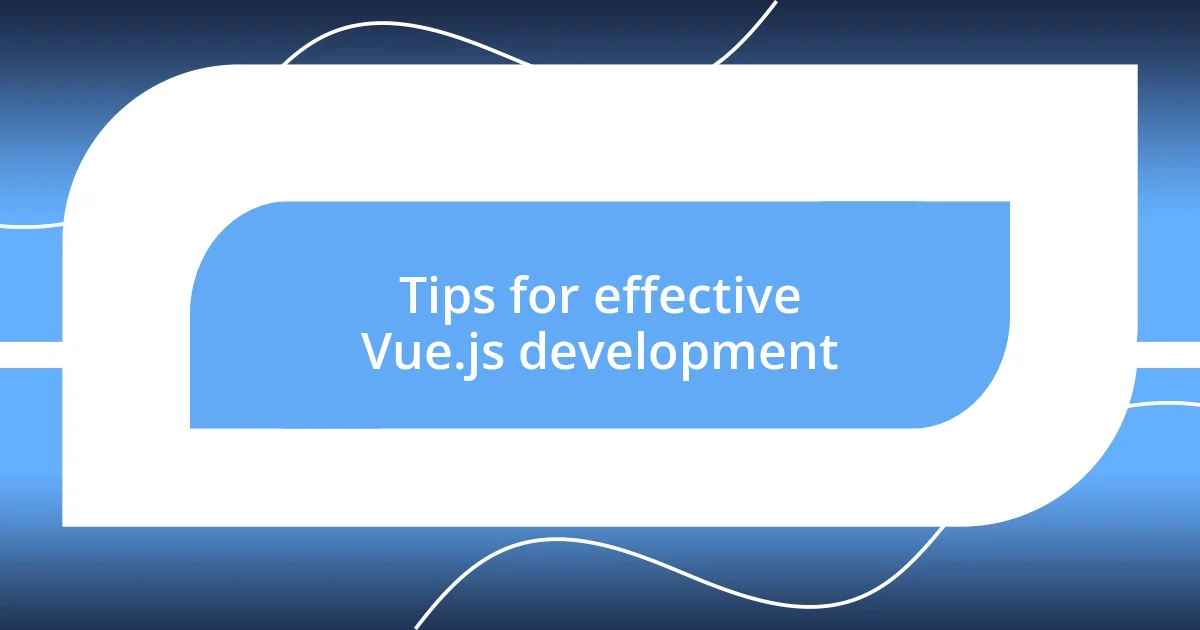Key takeaways:
- Experiencing a gentle learning curve and a supportive community made the transition to Vue.js enjoyable and encouraging.
- The flexibility and performance of Vue.js were crucial for rapid prototyping and handling real-time updates effectively.
- Overcoming challenges through community engagement, solid testing practices, and embracing component-based architecture enhanced both development skills and confidence.

My first encounter with Vue.js
I still remember the moment I first stumbled upon Vue.js. It was tucked away in an online tutorial that promised to simplify my JavaScript projects. Honestly, I was skeptical at first—how could this new framework possibly compete with the giants like React or Angular?
Diving into Vue felt like stepping into a cozy café after a long day. The learning curve was surprisingly gentle, and I found myself genuinely enjoying the process. I vividly recall the thrill I felt as I created my first interactive component—watching it respond in real-time felt like magic. Have you ever had that euphoric moment when you finally understand a complex concept? That was me with Vue, and it ignited a spark of curiosity that kept me eager to explore its features further.
As I continued to experiment, I remember feeling a sense of camaraderie with the community. It was refreshing to see how helpful and welcoming everyone was, especially when I inevitably hit roadblocks. I couldn’t help but think—what if every technology I encountered came with such a supportive network? This was just the beginning of my journey with Vue.js, and I was hooked!

Why I chose Vue.js
I chose Vue.js primarily for its simplicity and flexibility. One day, while juggling multiple projects, I realized I needed a framework that would allow me to quickly prototype and iterate without getting bogged down in complexity. Vue’s approachable syntax felt like a breath of fresh air, making it easy to integrate with existing projects. It was during a frantic late-night coding session that I discovered just how effortlessly I could adapt Vue.js to meet my needs.
The community surrounding Vue made a huge difference in my decision, too. I remember diving into forums after struggling with a particular component — it was like having a supportive group of friends ready to help at my fingertips. Their enthusiasm was infectious, and I found myself not only learning but also wanting to contribute back. That sense of belonging really solidified my choice, as it reminded me of the power of collaboration, which I truly value in my work.
Lastly, the performance of Vue.js has been a game changer for me. In a project I worked on recently, I needed a solution that could handle real-time updates without lag. I vividly recall the moment I did a performance comparison and saw Vue’s reactivity shine compared to the other frameworks I had previously used. It was the reassurance I needed that I had made the right choice for my projects.
| Criteria | Vue.js | Other Frameworks |
|---|---|---|
| Learning Curve | Gentle | Steeper |
| Community Support | Very Active | Variable |
| Performance | High | Varies |

Key features that impressed me
I found several key features of Vue.js that genuinely impressed me throughout my projects. For starters, its reactivity system was a revelation. When I modified a data property, I was amazed at how effortlessly the view updated in real time, almost like watching a painting come to life. I remember feeling that rush of excitement as I realized I could build dynamic interfaces with minimal code — it made me feel empowered as a developer.
Here are some other standout features that caught my attention:
- Two-Way Data Binding: Simplified synchronization between model and view.
- Component System: Promoted reusable code, making my projects much cleaner and organized.
- Single-File Components: Allowed me to encapsulate HTML, CSS, and JavaScript in one file, which streamlined the development process.
- Vue Router: Made it easy to implement client-side routing, providing a seamless user experience as I navigated between pages.
Additionally, the built-in directives, like v-for and v-if, allowed me to implement logic directly in the HTML, cutting down on the need for boilerplate code. I can still vividly remember a late-night debugging session where I realized these features turned what could have been a tedious task into a quick, enjoyable process. There’s something incredibly satisfying about writing less code but achieving more functionality!

Building my first Vue.js project
Building my first Vue.js project felt like embarking on a thrilling adventure. I decided to create a simple to-do list application, a common starter project, yet I was excited by the possibilities. As I started piecing it together, I was struck by how intuitive everything felt; the moment I set up a component, it clicked into place as if the framework was guiding my hands. Did you ever feel that rush when everything just comes together seamlessly? I certainly did.
I remember hitting a wall when I tried to implement some complex functionality, and initially, I was frustrated. But then, I found myself revisiting the rich documentation and community forums, and with each small victory, my confidence grew. It was exhilarating to watch that to-do list update in real time as I added tasks, and I felt a sense of accomplishment that was genuinely profound. Building that first project wasn’t just an exercise in coding; it was about learning to trust my instincts and enjoy the process of creation.
What struck me most was the joy of simplifying what could be a daunting process. That feeling of empowerment when I realized I could construct an entire application with clean, manageable code was incredible. I might have been a bit hesitant at first, but as I worked through challenges, I could sense my skills growing. Looking back, I now understand how each small step shaped my confidence in using Vue.js, setting the stage for even more ambitious projects down the line.

Challenges I faced during development
While navigating my way through development with Vue.js, I encountered a few hurdles that tested my problem-solving skills. One significant challenge was managing state across multiple components. I remember one late night, feeling the weight of frustration as I struggled to synchronize data between sibling components. It was a classic case of “why won’t this work?” After diving headfirst into Vuex, Vue’s state management library, I finally found the light at the end of the tunnel. The learning curve was steep, but overcoming that obstacle felt like leveling up my skills genuinely.
Another hurdle was dealing with asynchronous operations, especially when fetching data from APIs. Have you ever experienced that heart-sinking moment when your application breaks because the data you expected just wasn’t there? I certainly have. During one project, I spent hours trying to debug an issue that appeared only when components re-rendered with incomplete data. It was through trial and error—and plenty of console logging—that I learned about lifecycle hooks and how to properly manage my asynchronous requests. Each challenge forced me to think more critically, ultimately transforming frustrating moments into valuable lessons.
Lastly, I noticed that keeping up with the latest updates and best practices in the Vue.js ecosystem could be quite overwhelming. Every few months, new features and plugins seemed to pop up like mushrooms after rain. At times, I found myself questioning if I was using Vue the “right” way. This made me realize that continuous learning is part of being a developer. Engaging with the community through forums and attending meetups helped me stay grounded, ensuring I wasn’t just keeping pace but truly enriching my experience with Vue.js. In all honesty, I believe it’s these challenges that made my journey not just about coding, but about developing resilience and adaptability in the ever-evolving tech landscape.

Tips for effective Vue.js development
When diving into Vue.js development, one of the best tips I can offer is to embrace the component-based architecture fully. I distinctly remember my first few attempts at structuring my components. At first, I tried to make everything a bit too complex, which just led to confusion. But once I focused on breaking my application down into smaller, reusable components, the entire development process became smoother, almost like following a well-laid-out path instead of wandering in the woods. Have you ever felt the stress of trying to manage too many pieces at once? Simplifying your structure can relieve that burden.
Another crucial tip is to leverage the Vue Devtools extension. I can’t stress enough how it transformed my debugging sessions. Once I started using it, I felt like I had a powerful magnifying glass zooming in on the inner workings of my app. Seeing real-time changes and monitoring the state of my components helped me grasp what was happening under the hood. Do you ever find debugging to be an intimidating task? Trust me, with the right tools, it can become an enlightening experience.
Lastly, don’t underestimate the importance of writing good documentation. Early on, I neglected this essential part of development and later regretted it when I had to revisit my code after some weeks. I remember the “what was I thinking?” moments. I’ve since learned to annotate my components and define clear usage patterns. This practice not only aids your future self but also helps other developers who might work on the same project. Isn’t it nice to think about how your notes could help someone else navigate your code with ease? Making documentation an integral part of your workflow can elevate not just your efficiency but also your collaboration with others in the development community.

Lessons learned from using Vue.js
Reflecting on my journey with Vue.js, I learned that flexibility in design is vital. I vividly recall a time when I had this rigid layout set in stone, believing it would save time. However, as I encountered new features I wanted to integrate, I realized the structure was too confining, stunting creativity. The lesson? Leave room for adjustments. The ability to adapt your designs not only enhances the user experience but streamlines your development process.
I also discovered the significance of building a robust testing strategy early on. In one project, I skipped writing tests to meet deadlines, only to face a barrage of bugs later. The frustration was palpable, almost like wrestling with a shadow that wouldn’t go away. That experience taught me that investing time in testing upfront pays off massively down the road. Wouldn’t it be better to catch issues before they become a headache? Embracing tools like Jest or Mocha for unit testing can truly transform the way you develop.
Finally, I found that community support is an essential ingredient in mastering Vue.js. During tough moments, like when I was unsure whether to implement a new feature or not, turning to forums for advice provided clarity and renewed motivation. Have you ever felt the isolation of coding alone, wishing for a sounding board? Engaging with fellow developers shifted my perspective and bolstered my confidence. Connecting with others who share your struggles and triumphs can make this journey not only more enriching but also less daunting.














